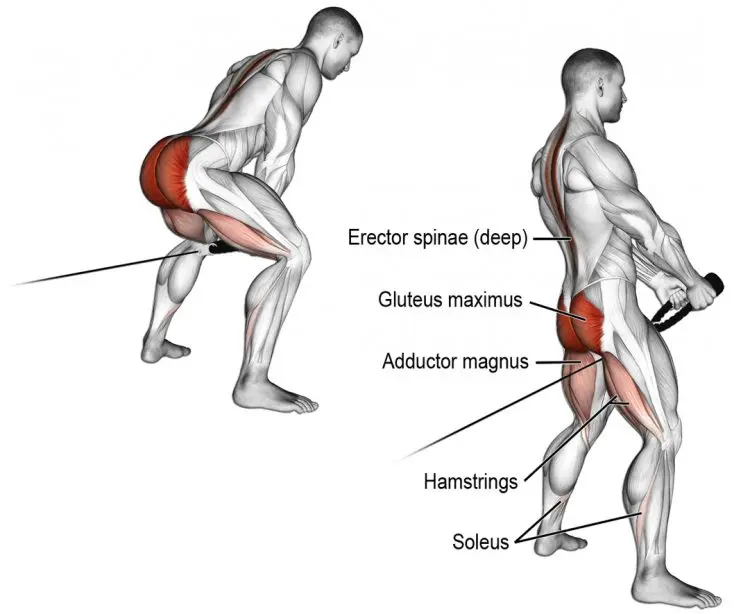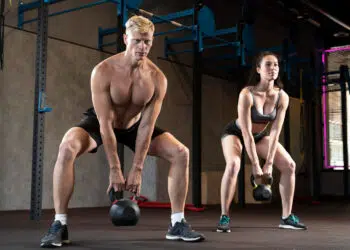Cable pull-throughs are a FANTASTIC glute and hamstring exercise. However, unlike most posterior chain exercises, your lower back isn’t stressed too heavily, so you can really focus on beefing up your butt and hammies.
Because of this, cable pull-throughs are very popular, and that exercise popularity is a double-edged sword. On the plus side, you won’t raise too many eyebrows when you do this exercise in your local gym. In contrast, not so long ago, if you did cable pull-throughs, you’d have stuck out like the proverbial sore thumb!

But, on the downside, many exercisers act like they’re married to cable pull-throughs and are very reticent to be unfaithful to their favorite hamstring and butt-builder. They do it all the time, and that’s where the problems start…
Unfortunately, as effective as cable (and resistance band) pull-throughs undoubtedly are, they’ll become less potent if you do them too often. Your body is the master adapter and, if you do any exercise too often, you’ll start to get used to it, and your progress will stall.
Some people simply do not like cable pull-throughs and find them awkward or uncomfortable.
The good news is that there are plenty of exercises you can do instead of cable pull-throughs. Each one hits the same major muscles but uses a different training tool or alternate movement to do it.
Level Up Your Fitness: Join our 💪 strong community in Fitness Volt Newsletter. Get daily inspiration, expert-backed workouts, nutrition tips, the latest in strength sports, and the support you need to reach your goals. Subscribe for free!
So, whether you are in danger of getting bored of cable pull-throughs or just don’t like them, use the 13 exercises outlined below to build a strong and muscular posterior chain.
Top Cable Pull Through Substitutes / Alternatives
Cable pull-throughs are a highly effective posterior chain exercise, but that doesn’t mean you need to do them all the time. There are numerous alternatives you can use to keep your workouts productive and interesting:
1. Sled Pull-through
You don’t need a cable machine to do pull-throughs. You can also do them using a resistance band. But, if you prefer to walk while you work out, give sled pull-throughs a try. This unusual exercise works the same way as regular pull-throughs, but there is no eccentric component to any of your reps.
Concentric-only training usually produces less muscle soreness than isotonic workouts. This is a good exercise for athletes who don’t want to impede their future workout performance.
How to do it:
- Stand with your back to your sled. Grab both handles and then step over the tow straps so they are between your legs. With your hands between your legs, hinge forward from your hips, reach back between your legs and walk forward until the straps are tight.
- Drive your hips forward and stand up, just like at the start of a kettlebell swing.
- Lean and step forward to get ready for another rep.
- Do not round your lower back when doing this exercise.
2. Kettlebell Swings
Kettlebell swings involve the same hip hinge movement as cable pull-throughs. However, this exercise is done much more explosively, making it better for increasing muscle power.
A lot of exercisers view kettlebell swings as a conditioning or endurance exercise but, done with a heavy weight, they’re a very effective power exercise. On the downside, to get the most from heavy swings, you’ll need a hefty (40kg/88lbs+) kettlebell, and they’re not as common as lighter kettlebells.
Learn how to do kettlebell swings here.
3. Overhead Medicine Ball Throw
Overhead medicine balls involve a rapid hip hinge followed by a powerful hip extension, making them a legitimate alternative to cable pull-throughs. However, medicine ball overhead throws are done explosively, making them great for building posterior chain power.
Take care; you will need plenty of space to do this exercise and, for the sake of safety, it’s probably best done outside.
How to do it:
- Stand with your feet shoulder-width apart and hold a medicine ball in front of your hips. Brace your core and pull your shoulders down and back.
- Hinge forward from your hips and lower the ball between your knees. Do not round your lower back.
- Without bending your arms, stand up explosively and throw the ball up, overhead, and behind you. Do not throw it straight up; that’s an accident waiting to happen.
- Retrieve the ball and then repeat.
4. Sled Forward Drag
Facing forward as you drag a weighted sled involves a powerful hip extension that works your glutes and hamstrings one leg at a time. This is a very back-friendly alternative to many posterior chain exercises, including deadlifts, Romanian deadlifts, and, of course, pull-throughs. With no eccentric contraction to contend with, this exercise should not produce too much muscle soreness, even if you go hard and heavy.
How to do it:
- Stand with your back to your sled and hold the handles behind you.
- Brace your abs and walk forward.
- Use a waist belt or harness to free up your arms.
- You can also do this exercise in the bear crawl position with your hands on the floor.
- Turn this into a posterior chain power exercise by sprinting instead of walking.
5. Romanian Deadlift
Romanian deadlifts look and feel a lot like cable pull-throughs. They feature the same hip hinge motion and target the same muscles. The main difference is that the weight is in front of you, which puts more stress on your lower back than cable pull-throughs. However, done with good form, most exercisers can do Romanian deadlifts safely, even when using heavy weights.
Read more about Romanian deadlifts in our detailed guide.
6. Barbell Hip Thrust
No cable machine? No problem! You can get a very effective glute workout using nothing more than a barbell and a weight bench. Like cable pull-throughs, barbell hip thrusts put your glutes under maximal tension at the top of each rep. In fact, contrary to appearances, the movements are very similar. Barbell hip thrusts are also very lower back-friendly.
Level Up Your Fitness: Join our 💪 strong community in Fitness Volt Newsletter. Get daily inspiration, expert-backed workouts, nutrition tips, the latest in strength sports, and the support you need to reach your goals. Subscribe for free!
Learn how to do barbell hip thrusts here.
7. Kneeling Banded Hip Thrust
This low-tech but high effect exercise puts your glutes under a lot of tension as you reach the midpoint of each rep. There is no load on your spine, so it’s a very lower back-friendly exercise. While this exercise is typically done kneeling, it can also be done standing.
How to do it:
- Attach a loop-type resistance band to a low anchor point. With your back to the anchor, kneel down with the band around your waist. Shuffle forward to tension the bend.
- Push your hips back, kneel down, and then drive them forward and up against the tension offered by the band. Squeeze your glutes at the point to fully contract the target muscles.
- Push your hips down and back and repeat.
- If you are using a very strong band, it may be necessary to brace and balance yourself by holding onto something like an exercise bench or the uprights of a squat rack.
8. Reverse Hyperextension
When you do cable pull-throughs, your legs remain stationary while your upper body moves. With reverse hyperextensions, it’s your upper body that stays still as you lift and lower your legs. This difference aside, reverse hyperextensions work the same muscles as cable pull-throughs. However, you will need a reverse hyperextension machine to do this particular exercise.
How to do it:
- Lie face down on the reverse hyper machine. While your upper body and stomach should be on the bench, your hips should not. This will allow them to move freely.
- Let your legs hang straight down toward the floor. Hold the handles to keep your upper body in position. Brace your abs to keep your spine stable and supported.
- Lift your legs by contracting your hamstrings, glutes, and lower back. Keep them straight. Raise them until they are roughly parallel to the floor. Keep the movement smooth and controlled. Do not kick your legs up; otherwise, momentum will take work away from the target muscles. You could also hurt your lower back.
- Lower your legs and repeat.
Related: Reverse Hyperextension Guide
9. Single Leg Romanian Deadlifts
Most cable pull-through alternatives, like the pull-throughs themselves, are bilateral or two-legged exercises. However, in nature, you’ll often need to use your posterior chain unilaterally. Single leg Romanian deadlifts are an effective unilateral posterior chain exercise that’s good for developing better balance. You can also use this exercise to address any left to right strength imbalances you might have.
Check out our in-depth guide to learn more about this awesome exercise.
10. Hyperextensions
Most people know hyperextensions, also known as 45-degree back extensions, as a lower back exercise. In actuality, they’re a total posterior chain workout. You don’t have to limit yourself to just your body weight for this exercise; hold weights in your hands or use a resistance band around the back of your neck to make it harder.
Check out our in-depth guide and learn how to do this exercise.
11. Reverse Deficit Lunges
Lunges are often thought of as a quadriceps exercise. But, if you lunge backward, you’ll feel them more in your glutes and hamstrings, just like cable pull-throughs. Yes, your quads ARE still involved, but to a lesser degree compared to forward lunges.
Using a deficit further increases glute and hamstring engagement by taking your hips through a larger range of motion. Reverse lunges tend to be more knee-friendly than forward lunges, which is a bonus if you suffer from knee pain.
How to do it:
- Stand on a 6” platform with your feet together and arms by your sides. Use dumbbells if you wish.
- Take a large step back. Keeping your front shin and torso upright, bend your legs and lower your rear knee down to within an inch of the floor.
- Push off your back leg and bring your feet back together.
- Do all your reps with the same leading leg and then switch sides, or alternate legs rep by rep as preferred.
12. Standing Long Jump
This is a valuable bodyweight alternative to cable pull-throughs. Take a moment to analyze the movement. You’ll soon see that this exercise and cable pull-throughs share several similarities. Take care on landing; like all jumping exercises, there is a lot of impact to absorb. This move is best avoided by anyone who is significantly overweight or has lower limb injuries.
How to do it:
- Stand with your feet roughly shoulder-width apart. Look straight ahead and brace your core.
- Bend your knees and swing your arms behind you.
- Swing your arms and jump forward and upward, aiming to cover as much distance as possible.
- Land on bent knees and “stick” your landing.
- Reset and repeat.
13. Stability Ball Hip Lift and Leg Curl
This bodyweight exercise combines two movements to really hammer your hammies and glutes. There is very little stress on your lower back, so they’re a lot like cable pull-throughs.
How to do it:
- Lie on your back with your legs straight and feet resting on a stability ball. Place your hands on the floor by your side for balance.
- Push your heels into the ball to lift your butt off the floor, so your body is straight.
- Next, bend your legs and curl the ball in toward you. Push your hips up to the ceiling as you roll the ball in.
- Push the ball away so your legs are straight, and then lower your hips back down to the floor.
- That’s one rep – keep going!
More Alternative Exercises:
- Best Calf Raise Machine Alternatives
- Bulgarian Split Squat Alternatives
- Hanging Leg Raise Alternatives
- Leg Extension Alternatives
- Best Leg Curl Alternatives
- Best Hack Squat Alternative
- Best Box Jump Alternatives
- Best Alternatives to Lunges for Bad Knees
- Romanian Deadlift Alternatives
- Leg Extension Alternatives
- Leg Curl Alternatives
Cable Pull Through Alternatives – Wrapping Up
Cable pull-throughs are popular for a reason – they work! If you want to strengthen your glutes and hamstrings while taking it easy on your lower back, cable pull-throughs are an excellent choice.
That said, when it comes to productive workouts, variety is just as important as things like weight, rep range, and training volume. Your muscles will soon become accustomed to any exercise you do over and over again, and that will affect your rate of progress.
So, keep yourself out of training ruts by using a range of exercises and not the same ones over and over again. Even minor variations can be enough to maintain your progress.
Use the 13 cable pull-through alternatives in this article to ensure your glutes and hamstrings continue to get stronger and more muscular. You don’t have to give up cable pull-throughs indefinitely. Still, even a one-month break could be enough to make this exercise productive again.
Interested in measuring your progress? Check out our strength standards for Bulgarian Split Squat, Hack Squat, Deadlift, and more.








